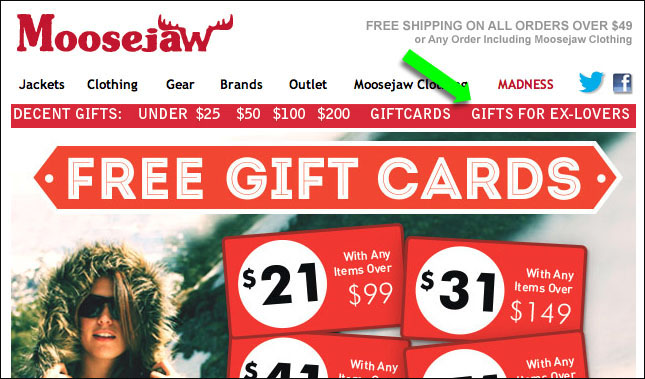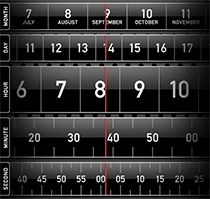A small chain of outdoor adventure clothing shops based in Ann Arbor, Michigan sends me emails from time to time since I am a regular customer. Today’s email was a holiday promotion but what caught my eye was a link titled, “Gifts for Ex-Lovers”.

Like everyone, I have ex-lovers so my curiosity got me and I wanted to see what the gang at Moosejaw would suggest I give an ex. If you’re unfamiliar with the psyche of the company, one day this past summer, they were bored, took a hunk of bologna and a deli meat slicer up to the roof of their headquarters and whipped sliced bologna at passing cars and made a video of the fun! (click here, opens in new window). Suffice it to say, they’re an irreverent bunch… one reason for their success in their target demographic I’m sure.
 I clicked the link and was sent to a page of the site containing 16 items that I guess they deemed appropriate for ex-lover, most of which I’d be grateful if an ex-lover sent me. A few stood out from the rest (and I’m keeping my comments to myself): a “Ruffwear Roamer Leash”, a “Black Diamond Pecker” (that’s it to the right), a “SOG Flash I Knife”, and a “Back Country Access B1 Shovel”. Hmmmmm.
I clicked the link and was sent to a page of the site containing 16 items that I guess they deemed appropriate for ex-lover, most of which I’d be grateful if an ex-lover sent me. A few stood out from the rest (and I’m keeping my comments to myself): a “Ruffwear Roamer Leash”, a “Black Diamond Pecker” (that’s it to the right), a “SOG Flash I Knife”, and a “Back Country Access B1 Shovel”. Hmmmmm.
In any case, I’m guessing that link in the email will get the most click-throughs of any. Think outside the box, be different, and be successful!
.


 You receive a phone call from a prospective client asking you to “bid” on an upcoming photography project she has. It’s an opportunity to forge a new relationship with a new client and you really want the job. Here are a couple of guidelines that have served me well, resulting in me being selected as the successful “bidder”:
You receive a phone call from a prospective client asking you to “bid” on an upcoming photography project she has. It’s an opportunity to forge a new relationship with a new client and you really want the job. Here are a couple of guidelines that have served me well, resulting in me being selected as the successful “bidder”:


 I clicked the link and was sent to a
I clicked the link and was sent to a  I’d best describe this day-long gathering of some of the brightest minds in our business as enlightening and thought-provoking. (If you were unable to attend or did not watch it live, a complete video archive of event is available
I’d best describe this day-long gathering of some of the brightest minds in our business as enlightening and thought-provoking. (If you were unable to attend or did not watch it live, a complete video archive of event is available  Ever find yourself at the end of the day asking, “where did the time go?” Or, perhaps you’ve thought to yourself, “I wish I had more time for this project.”
Ever find yourself at the end of the day asking, “where did the time go?” Or, perhaps you’ve thought to yourself, “I wish I had more time for this project.”  groozi.com is a blog about negotiating and web marketing. Weekly posts are written primarily by me, Blake J. Discher, a
groozi.com is a blog about negotiating and web marketing. Weekly posts are written primarily by me, Blake J. Discher, a 
